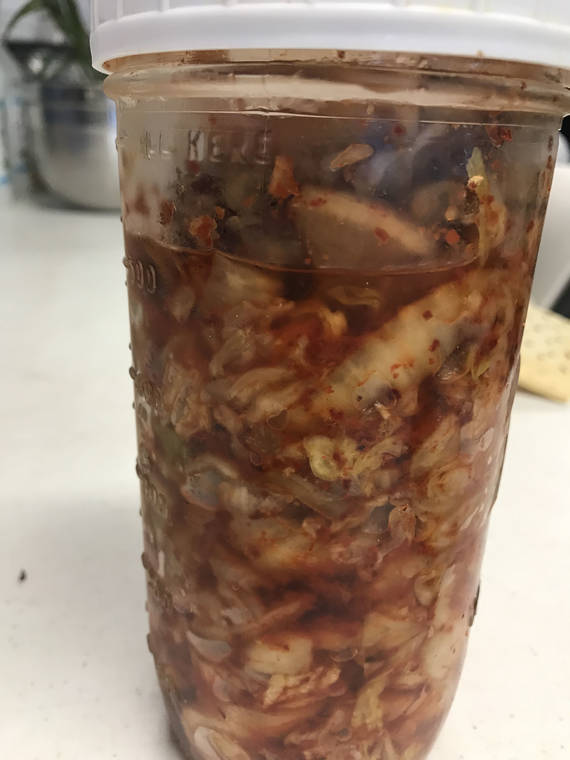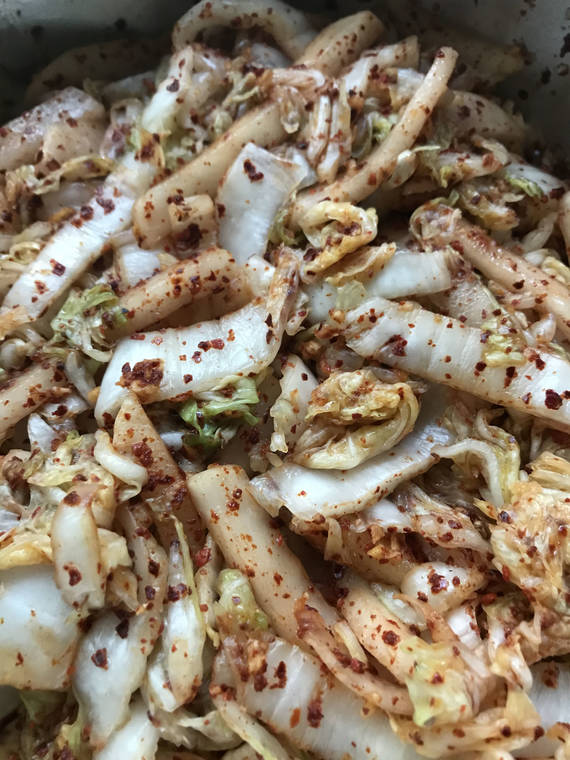The best words to describe kimchi are spicy, fermented and maybe even funky. Fermented means it is a probiotic, which is great for our gut.
Earlier this year, I had Tracy Kim on my “Audrey Wilson’s Cooking Show” on NaLeo TV and she made kimchi. But unfortunately, she did not have a recipe written down — everything was by her experience and eyeballing.
So, in pursuit of a recipe, I found this one.
In 2016, Sunset magazine featured Chong and son Matt Choi’s method of making kimchi. At that time, they were selling their kimchi at the downtown Portland, Ore., farmers market,
Here is their story:
Choi’s Kimchi Co. makes hand-crafted kimchi, making it in small batches in the same process that has been handed down from generation to generation. In 2011, they “took our first kimchi sample to the Portland Farmers Market and I strongly sensed that this was going to be a turning point in my life.”
Mrs. Choi remembers, “I love the vibrant atmosphere of the farmers market in downtown Portland, where there is an abundance of fresh produce, food, music and people enjoying life. I’m always inspired by the farmers market and want to share my kimchi with this community that I adore. I often talked about starting a kimchi business. The farmers market was a perfect place to begin.
“To me, kimchi is not just food. It represents my country, Korea. I make my kimchi with pride, knowing each batch contains the roots of my heritage.”
I love hearing about these success stories, as it was my dream to be able to help folks on the Big Island get started, perhaps first at farmers market, then get so successful they eventually go on to develop a viable, profitable business. That is why I started my nonprofit company and opened a certified kitchen to help new businesses start up.
I am delighted when a small business leaves us because they opened their own operation and are doing well, like when your children leave the house and become successful and happy!
The essential ingredient to making kimchi is gochugaru, or sun-dried red chiles, and coarse salt, such as kosher salt. Vegetables needed are Napa or Chinese cabbage and Korean daikons. When selecting the cabbage, look for green on the outside and yellow inside.
Choi’s Napa Cabbage Kimchi
Makes: 3 pints
1 small head Napa cabbage (2 pounds)
4 ounces daikon radish (center section), peeled and sliced 1/4-inch thick, then cut into 1-inch pieces
1/4 cup coarse sea salt or kosher salt
1/4 Asian pear
1/4 cup ground Korean gochugaru chile
2 tablespoon minced yellow onion
5 medium garlic cloves, minced
1/2 teaspoon minced fresh ginger
1 1/2 teaspoon Thai or Vietnamese fish sauce (nam pla or nuoc nam)
1/2 teaspoon sugar
1 green onion, white end halved lengthwise, then entire onion cut into 1 1/2-inch lengths
Quarter cabbage lengthwise. Cut out and discard the core at the base of each quarter, then slice cabbage crosswise into 2 1/2-inch pieces. Put cabbage in a large bowl, cover with water, and let sit for a minute.
Drain cabbage and return to the bowl. Add the daikon radish, sprinkle it with salt and toss with your hands to mix thoroughly.
Press down on vegetables to compact them, let sit at room temperature for 20 minutes. Stir to redistribute the salt and let vegetables sit uncovered at room temperature, 5-6 hours (no need to stir again).
Put vegetables in a large bowl of cold water and swish to rinse, then drain and repeat until it is as salty as you like.
Choi: “I change the water up to three times, tasting as I go to gauge saltiness. The thickest part of the cabbage won’t taste salty and will have crunch, but the leafy part will be wilted and you’ll taste a little salt.”
After the final draining, gently squeeze out most of the liquid and transfer vegetables to a large, clean, dry bowl. Peel, halve and core Asian pear.
Choi: “The pear adds natural sweetness and is refreshing to the palate.”
Cut into 1/4-inch wide pieces (you should have about 3/4 cup).
Add pear to the bowl with all remaining ingredients except the green onion. Mix thoroughly, then gently mix in the green onion.
Choi: “Mix the green onion in at the end so it doesn’t bruise and looks nice.”
Pack kimchi into two clean 1-pint jars, leaving 1 1/2-inches of headspace below the rim. Push vegetables down firmly into the jars so the liquid within the jar rises.
Seal jars with a tight-fitting lid and let sit on a rimmed baking sheet at room temperature, away from direct sunlight. Fermentation time varies, but at warm room temperature, it should take 2-3 days. If it’s cool, up to one week.
Sample the kimchi regularly (it might fizz a little when you open the jar, a sign that the fermentation is working). Open jars over the sink in case they drip.
Choi: “As the kimchi ferments, more liquid will come out of the vegetables. Check the jars every day and push down on the kimchi to cause the juices to come up. This ferments the topmost part of the jar.”
When the kimchi is nicely tangy, it’s ready to eat. It will keep, refrigerated, for up to three months.
•••
Besides eating kimchi as a side dish, you can add it and its juices to tomato juice with a shot of pepper vodka to make a spicy bloody Mary or chop kimchi with diced avocados and mango for a salsa with grilled fish, or add chopped kimchi to fried rice, or even top a hot dog with kimchi and mustard.
Email Audrey Wilson at audreywilson808@gmail.com.









